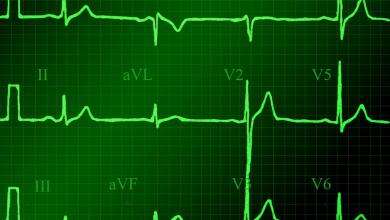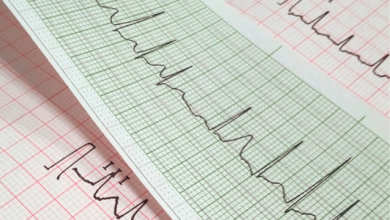Search results
Author(s):
Demosthenes G Katritsis
,
Bernard J Gersh
,
A John Camm
Added:
3 years ago
Early repolarisation pattern is defined electrocardiographically by a distinct J wave or J-point elevation that is either a notch or a slur of the terminal part of the QRS entirely above the baseline, with or without ST-segment elevation. The peak of the notch or slur (Jp) should be ≥0.1 mV in two or more contiguous leads, excluding leads V1 to V2 (see Figure 1).1,2 Early repolarisation syndromes…
View more
Author(s):
Manoj N Obeyesekere
,
Andrew D Krahn
Added:
3 years ago
Early repolarisation (ER) is defined as J-point elevation of ≥0.1 mV in two adjacent leads with either a slurred or notched morphology (Figures 1 to 4).1,2 Numerous studies have established an association with ER and increased risk of death and idiopathic ventricular fibrillation (VF).1–5 Clinicians face questions such as patient and family counselling, quantitifying the risk of sudden cardiac…
View more
Author(s):
Giulio Conte
,
Ulrich Schotten
,
Angelo Auricchio
Added:
3 years ago
The Risk of Atrial Arrhythmias in Inherited Primary Arrhythmia Syndromes
The inherited primary arrhythmia syndromes (IPAS) are a heterogeneous group of diseases caused by mutations in genes encoding for cardiac ion channels. People affected by one of these inherited diseases have no overt structural cardiac abnormalities but are at higher risk of sudden cardiac death due to the occurrence of…
View more
Author(s):
Neil T Srinivasan
,
Richard Schilling
Added:
3 years ago
An estimated 180,000–300,000 sudden cardiac deaths (SCD) occur in the US annually.1,2 Worldwide, sudden and unexpected cardiac death is the most common cause of death,2 accounting for 17 million deaths every year with SCD accounting for 25% of these. The accepted definition of SCD is death that occurs within one hour of onset of symptoms in witnessed cases, and within 24 hours of last being seen…
View more
Author(s):
Megan Barber
,
Jason Chinitz
,
Roy John
Added:
3 years ago
Ventricular arrhythmias are designated idiopathic when demonstrable structural heart disease, significant coronary disease including coronary spasm or genetic arrhythmia syndromes are absent.1 These arrhythmias may be benign but are also a recognised cause of sudden cardiac death. The common form of idiopathic ventricular tachycardia (VT) originates in the ventricular outflow tracts, manifest…
View more
Author(s):
Giulio Conte
,
Maria Luce Caputo
,
François Regoli
,
et al
Added:
3 years ago
General understanding of early repolarisation (ER) has dramatically changed in the last decade. For several years, ER has been considered a benign electrocardiographic (ECG) finding with high prevalence in the general population. Recently different studies have challenged this view and showed a significant association with life-threatening arrhythmias.1–5
In 2008 Haïssaguerre et al. first…
View more
Author(s):
Benedict Wiles
,
Anthony C Li
,
Michael C Waight
,
et al
Added:
1 year ago
Author(s):
Greg Mellor
,
Elijah R Behr
Added:
3 years ago
Sudden unexplained death syndrome (SUDS)1 is rare in the young but when it occurs it is devastating for family and friends, and affects whole communities. That it can affect fit, athletic individuals and may be related to competitive sports only adds to the sense of incomprehension and injustice felt by wider society. In comparison with the older population, where sudden death is more common and…
View more
Author(s):
Justine Bhar-Amato
,
William Davies
,
Sharad Agarwal
Added:
3 years ago
Ventricular tachyarrhythmias (VAs) most commonly occur early in ischaemia, and patients presenting with an acute MI and ventricular arrhythmias are a group that has a significantly increased risk of mortality.1,2 Thrombolysis primary percutaneous coronary intervention (PCI) and use of beta-blockers, while resulting in the modification of the natural history of an infarct, have also reduced the…
View more
Author(s):
Gonca Suna
,
Greg J Mellor
Added:
4 months ago















